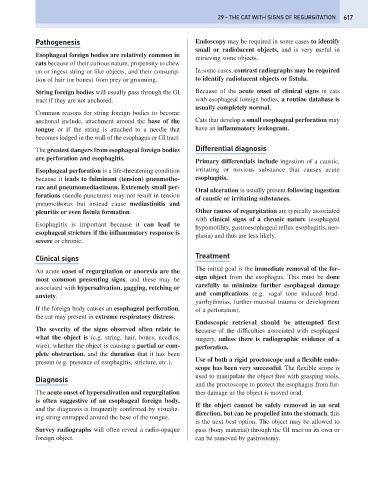Page 625 - Problem-Based Feline Medicine
P. 625
29 – THE CAT WITH SIGNS OF REGURGITATION 617
Pathogenesis Endoscopy may be required in some cases to identify
small or radiolucent objects, and is very useful in
Esophageal foreign bodies are relatively common in
retrieving some objects.
cats because of their curious nature, propensity to chew
on or ingest string or like objects, and their consump- In some cases, contrast radiographs may be required
tion of hair (or bones) from prey or grooming. to identify radiolucent objects or fistula.
String foreign bodies will usually pass through the GI Because of the acute onset of clinical signs in cats
tract if they are not anchored. with esophageal foreign bodies, a routine database is
usually completely normal.
Common reasons for string foreign bodies to become
anchored include, attachment around the base of the Cats that develop a small esophageal perforation may
tongue or if the string is attached to a needle that have an inflammatory leukogram.
becomes lodged in the wall of the esophagus or GI tract.
The greatest dangers from esophageal foreign bodies Differential diagnosis
are perforation and esophagitis.
Primary differentials include ingestion of a caustic,
Esophageal perforation is a life-threatening condition irritating or noxious substance that causes acute
because it leads to fulminant (tension) pneumotho- esophagitis.
rax and pneumomediastinum. Extremely small per-
Oral ulceration is usually present following ingestion
forations (needle punctures) may not result in tension
of caustic or irritating substances.
pneumothorax but instead cause mediastinitis and
pleuritis or even fistula formation. Other causes of regurgitation are typically associated
with clinical signs of a chronic nature (esophageal
Esophagitis is important because it can lead to
hypomotility, gastroesophageal reflux esophagitis, neo-
esophageal stricture if the inflammatory response is
plasia) and thus are less likely.
severe or chronic.
Clinical signs Treatment
An acute onset of regurgitation or anorexia are the The initial goal is the immediate removal of the for-
most common presenting signs, and these may be eign object from the esophagus. This must be done
associated with hypersalivation, gagging, retching or carefully to minimize further esophageal damage
anxiety. and complications (e.g. vagal tone induced brad-
yarrhythmias, further mucosal trauma or development
If the foreign body causes an esophageal perforation, of a perforation).
the cat may present in extreme respiratory distress.
Endoscopic retrieval should be attempted first
The severity of the signs observed often relate to because of the difficulties associated with esophageal
what the object is (e.g. string, hair, bones, needles, surgery, unless there is radiographic evidence of a
wire), whether the object is causing a partial or com- perforation.
plete obstruction, and the duration that it has been
present (e.g. presence of esophagitis, stricture, etc.). Use of both a rigid proctoscope and a flexible endo-
scope has been very successful. The flexible scope is
used to manipulate the object free with grasping tools,
Diagnosis
and the proctoscope to protect the esophagus from fur-
The acute onset of hypersalivation and regurgitation ther damage as the object is moved orad.
is often suggestive of an esophageal foreign body,
If the object cannot be safely removed in an oral
and the diagnosis is frequently confirmed by visualiz-
direction, but can be propelled into the stomach, this
ing string entrapped around the base of the tongue.
is the next best option. The object may be allowed to
Survey radiographs will often reveal a radio-opaque pass (bony material) through the GI tract on its own or
foreign object. can be removed by gastrostomy.

